Home
About Us
Current News
Event Calendar
Artist Bios
ARCHIVES
Display IDEAS
Collecting Tips
Gen Arts/Crafts Info
Testimonials
Hours/Directions
Online Store
ARCHIVES - Artist / Highlight of the Month
Navajo Rugs - March 2005
The Highlight of the Month program at The Indian Craft Shop focuses on a particular craft area, region or artist family/group. Our aim is to illustrate the diversity of tribal groups and the wide variety of artistic expressions and traditions in the country today.
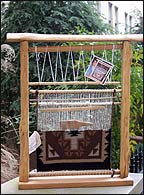
Navajo legends say that Spider Woman instructed the Navajo women how to weave on a loom which Spider Man told them how to make – the cross poles were made of sky and earth cords; the warp sticks of sun rays; the healds of rock crystal and sheet lightning; the batten was a sun halo; the comb of white shell. One spindle was a stick of zigzag lightning with a whorl of cannel coal; the second was a stick of flash lightning with a whorl of turquoise; the third was a stick of sheet lightning with a whorl of abalone; the fourth was a rain streamer with a whorl of white shell.
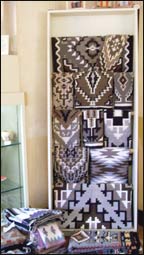
Wool rugs woven from the upright looms of Navajo weavers of the Southwest are among the world’s finest weavings. Traditionally taught by mother to daughter, today there are also a growing number of male weavers. The patterns and colors of Navajo weavings have evolved, resulting in classic designs and patterns, as well as innovative variations and new artistic expressions. Most historians believe the Navajo learned weaving techniques from the Pueblo Indians, descendants of the Anasazi who grew cotton and wove on upright looms over 1,000 years ago. Spanish settlers introduced wool from churro sheep to the Southwest region, and as the nomadic Navajo began to settle, they began to farm, raise their own sheep and produce their own style of weaving.
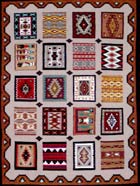
Navajo women became expert weavers, producing wearing blankets, dresses, skirts, breech cloths, sashes, garters and hair ties. Navajo weavings became so prized, a flourishing trade was built with the Spanish and other tribes. Early weavings were mostly saddle and wearing blankets with simple banded designs. These went through phases with the addition of geometric patterns. By the 1900s, the market for Navajo blankets expanded to rugs and weaving became market-oriented. Reservation trading posts greatly influenced this transition. These enterprising traders exposed rugs to a larger market and encouraged weavers to develop patterns, thereby supporting the evolution and expansion of this art form.
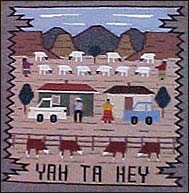
These Rug patterns and designs became named for the region of their origination. Today these designs have become known as the classic styles. Four are recognized by their colors alone: Ganado, Klagetoh, Two Grey Hills and Burntwater. The Ganado is known for its deep reds and central diamond designs, some with interlocking diamonds. The Klagetoh design is similar but typically has a grey background. The Two Grey Hills have variations of white, black, brown, tan and grey, traditionally bordered in black with a central design. Burntwaters are an elaboration of the Two Grey Hills, using a combination of warm earth tones and pastels. The Chinle, Wide Ruins and Crystal styles are recognized by their woven bands of color and the designs within those bands. These rugs generally have edge-to-edge bands of earth colors, with variations of repetitive patterns. Colors tend to be muted or pastels and are often vegetal dyes.
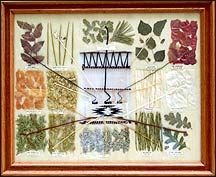
There are many other styles of weavings including: the Chief's Blanket, with variations on the earlier, banded patterns to later phases with geometric elements; the Teec Nos Pos, a design influenced by Persian rugs with an elaborate center and wide patterned border; the Storm, noted for its lightning pattern radiating from the center; the Germantown, known for patterns in reds, greens, yellows, blues and other bright colors that were first introduced in the1800’s from the yarn mills in Germantown, PA; and the Eye Dazzler, with colorful, busy lightning or zigzag patterns. Pictorials include depictions of a variety of themes including charming scenes of reservation life and patterns like the Tree of Life or Sandpainting and/or Yei/Yeibichai rugs based on symbolism and deities in the Navajo culture.
Special weaving techniques are used as well, such as the double weave or “two face” rugs, raised outlines and even rugs that are round in shape! Creating these masterpieces takes a great amount of skill and time (some up to a year), thus making them highly prized and appreciated works of art. Navajo weaving continues to evolve, as artists experiment with classic and contemporary designs and use the rainbow of available colors today.
©The Indian Craft Shop 2005


